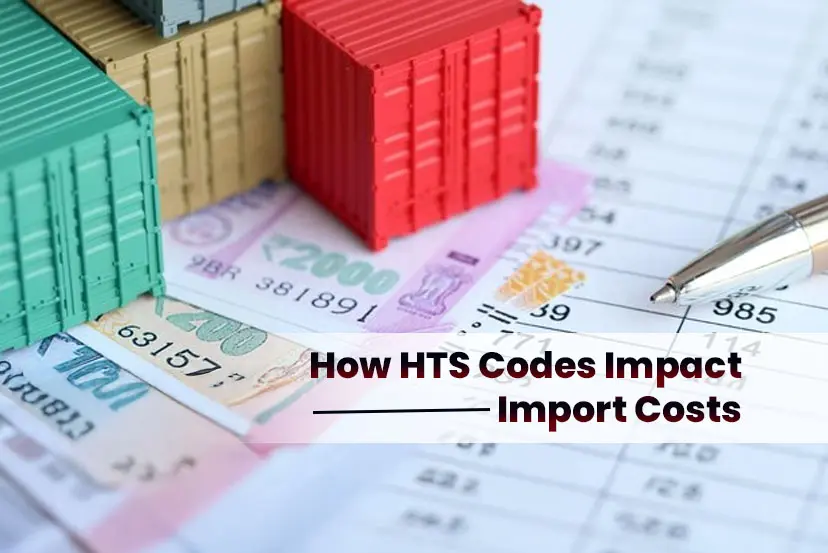In the complex world of international trade, importers face a multitude of factors that determine the total cost of importing products into a nation. Of all the factors to consider, Harmonized Tariff Schedule (HTS) codes play a vital part. HTS codes are a way to determine duty and tariffs directly, and thus the cost of importing goods. Understanding the HTS system, the use of the system, pricing, and trade compliance are pertinent for any business engaged in cross-border commerce.
How HTS Codes Directly Influence Import Costs?
There are many factors to consider that factor into your import costs: item price, freight, insurance, and customs duty. The HTS code’s impact is most significant on customs duties. Tariff rates are assigned by governments to specific HTS code classifications. The rates will vary widely depending on product classification and country of origin.
HTS Codes and Tariff Rate Application
Import tariffs associated with HTS codes will be applied mostly in the form of a few different types of duties:
- Ad Valorem Duties: A percentage of the declared customs value of the product.
- Specific Duties: A fixed charge for units, weight quantities, etc.
- Compound Duties: Combination of Ad Valorem + Specific Duties.
Each HTS code determines the import tariffs, affecting how much tax an importer pays for each customs transaction. For any given product, raw materials tend to have much lower duties than finished consumer goods.
Tariff Variation by Trade Agreements
Countries will apply different import tariffs based on trade relations with the exporting country.
- Standard rates for countries with “Normal Trade Relations.”
- Reduced or zero rates apply for countries with which we have Free Trade Agreements (FTAs), like the USMCA or GSP programs.
- Higher rates for countries with which you do not have normal trade.
Applying the right HTS code is essential for maximizing tariff schedule codes and benefiting from duty reductions. This can greatly affect your costs for the final dutiable costs of the product being imported.
The Consequences of Incorrect HTS Code Classification
An incorrect assignment of HTS codes to your imported product can create significant financial and operational challenges to your organization, such as:
- Higher Duties: Overestimating tariff rates unnecessarily inflates costs.
- Penalties for Underpayment: Underestimating the duties owed can lead to fines and payments owed when the underpayment is identified.
- Potential Delays in Obtaining Customs Clearance: If the goods are misclassified, they will face inspection holds.
- Increased Audit Risk and Potential Legal Issues: Misclassification on occasion or on a systemic basis will lead to increased scrutiny, potential penalties, and, in extreme cases, seizures of the goods.
The financial implications of misclassifying imported goods can lead to major delays and reputational risks with customs authorities.
How to Accurately Perform HTS Classification for Trade Compliance?
Maintaining trade compliance requires proper HTS code assignments to comply with customs law. To maintain trade compliance, an importer should:
- Know the Product in-Depth: An importer should possess an in-depth understanding of the product’s specifications, material composition, and intended use for proper classification of goods.
- Follow the Classification Rules: Take the time to follow the General Rules of Interpretation (GRI) consistently in the HTS code assignment process, for consistency and accuracy.
- Utilize Authoritative Resources: Take the time to utilize your official HTS and customs publications and databases for classification that is timely and accurate.
- Document all Decision-making: Keep a complete record of all classification decisions with a thorough record of the product, decisions made, and rationale in order to withstand an auditing context.
Tariff Reduction Strategies Utilizing HTS Codes
Businesses can implement proactive measures associated with HTS codes to lower import expenses. Key tariff reduction strategies include:
- Leverage Free Trade Agreements: When HTS codes are properly identified, it opens the possibility of customs duty exemptions or reductions outlined in many trade agreements, which leads to a reduction in duties due.
- Engage in Tariff Engineering: Design changes to products or the way goods are packaged can position products with HTS codes that include better tariff treatment without altering the product.
- Monitor and Reclassify Periodically: As tariff schedule codes periodically change and may offer new business benefits or cost containment, ongoing monitoring ensures that opportunities for reclassification can be identified.
- Request Binding Rulings from Customs Authorities: Receiving legally binding classification rulings means certainty with the HTS code used, and less risk for disputes or penalties from the government.
Factors Amplifying HTS Codes’ Role in Import Pricing
HTS codes affect a variety of cost elements besides import duties and are therefore crucial to the overall import pricing strategy. Key factors include:
- Landed Cost Calculation: HTS codes will be the basis of what tariffs and taxes are applied to a good, with these codes being critical components when accurately calculating landed cost, pricing, and ultimately profitability.
- Preferential Customs Treatment: The proper HTS classification will not only provide the importer with a basis to receive lower or no tariffs, but also provide the basis for relief from tariffs due to trade agreements, or quotas/specific systems that lower costs.
- Regulatory Compliance Related Costs: HTS codes affect administrative costs related to imports, amounts which include import processing fees to customs, compliance audits, and the potential costs associated with misclassification.
- Logistics and Inventory Management: Understanding the tariff burden associated with an HTS code is helpful for a business to appropriately source, plan logistics, and manage inventory levels.
Strategic Considerations for Businesses
To ensure effective management of import costs and compliance, businesses should:
- Integrate the knowledge of HTS codes into procurement, compliance, and supply chain.
- Encourage cooperation among legal, trade, purchasing, and product development functions to obtain the best tariff classification.
- Provide employees with training on tariff classification principles.
- Take advantage of advanced digital tools and classification software for accuracy and flexibility in the tariff schedule codes.
The benefits of these strategies ultimately ensure continued management of import costs and regulatory compliance.
Harnessing HTS Codes with Professional Support
HTS codes impact the cost and compliance factors of imported goods. With great HTS code classifications, overall organizations can better manage import tariffs regardless of changes, which lowers the top import costs, while confidently navigating through complex trade regulations. These complex tariffs and systems due to global trade will continue in the months and years ahead due to their complexities. Having a team of credible advisors, such as Credlix, will help ensure optimized import cost structures and regulatory compliance.
Frequently Asked Questions
Q1: Can HTS codes help in reducing tariffs legally?
Correct identification of HTS is necessary to access tariff reductions as part of trade agreements and tariff engineering.
Q2: Where should importers verify their HTS codes?
There are a number of official government customs sites, harmonized tariff databases, and licensed customs brokers to obtain reliable sources.
Q3: How often are HTS codes updated, and why does it matter?
HTS codes have a regular cadence of updating. HTS updates reflect new products, trade changes, or adjustments related to policy, compliance risk, and cost inefficiencies that can generally be avoided by maintaining current classification.




